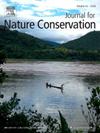A decade of implementing the Biodiversity management plan for African penguins – successes, failures and lessons learnt
IF 2.2
3区 环境科学与生态学
Q2 BIODIVERSITY CONSERVATION
引用次数: 0
Abstract
The rapid decline of the African penguin Spheniscus demersus in the early 2000 s triggered the drafting of the first African Penguin Biodiversity Management Plan (BMP) published in 2013, to “halt the decline of the African penguin population”. Working Groups (WGs) were created with stakeholders involved in penguin conservation to facilitate the implementation of the BMP. This study reviews the execution of the plan (1) from aide memoires and reports circulated within these WGs between 2013 and 2022; (2) by interviewing (in 2023) some of the stakeholders involved to assess their perceptions of the BMP 10 years post-implementation; and (3) by assessing the effectiveness of some actions using available scientific data. Interviewees unanimously agreed that the plan improved the species’s management and facilitated collaboration across institutions involved. Conservation actions identified as the most effective were 1) the rehabilitation of adults and chicks; 2) predator management and 3) habitat improvement with the provision of artificial nests. Scientific reviews of these actions validated their success. For example, rehabilitation effort may have increased the 2023 penguin breeding population by ca 7 %. Nevertheless, African penguin numbers continued decreasing and the species is now “Critically Endangered” on the IUCN Red List. Measures are still lacking in effectively increasing prey availability despite intensive engagement. Dedicated funding, trained capacity and accountability by relevant institutions undertaking their actions and deliverables were identified as essential for a more successful implementation of the BMP. Lessons learnt may pave the way for stronger conservation actions for African penguins and other threatened seabirds.
求助全文
约1分钟内获得全文
求助全文
来源期刊

Journal for Nature Conservation
环境科学-生态学
CiteScore
3.70
自引率
5.00%
发文量
151
审稿时长
7.9 weeks
期刊介绍:
The Journal for Nature Conservation addresses concepts, methods and techniques for nature conservation. This international and interdisciplinary journal encourages collaboration between scientists and practitioners, including the integration of biodiversity issues with social and economic concepts. Therefore, conceptual, technical and methodological papers, as well as reviews, research papers, and short communications are welcomed from a wide range of disciplines, including theoretical ecology, landscape ecology, restoration ecology, ecological modelling, and others, provided that there is a clear connection and immediate relevance to nature conservation.
Manuscripts without any immediate conservation context, such as inventories, distribution modelling, genetic studies, animal behaviour, plant physiology, will not be considered for this journal; though such data may be useful for conservationists and managers in the future, this is outside of the current scope of the journal.
 求助内容:
求助内容: 应助结果提醒方式:
应助结果提醒方式:


